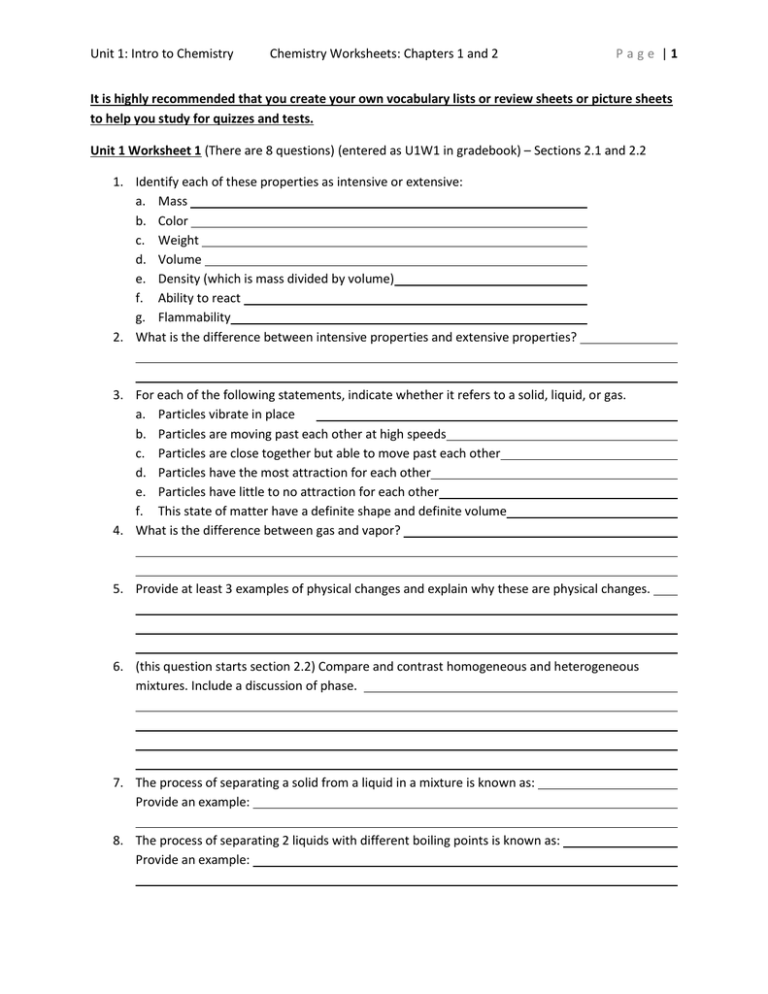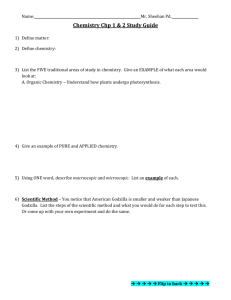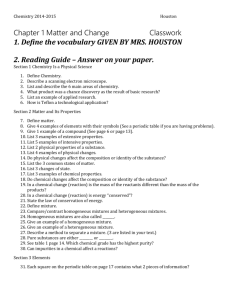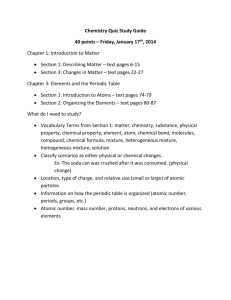Unit 1: Intro to ChemistryChemistry Worksheets: Chapters 1 and
advertisement

Unit 1: Intro to Chemistry Chemistry Worksheets: Chapters 1 and 2 Page |1 It is highly recommended that you create your own vocabulary lists or review sheets or picture sheets to help you study for quizzes and tests. Unit 1 Worksheet 1 (There are 8 questions) (entered as U1W1 in gradebook) – Sections 2.1 and 2.2 1. Identify each of these properties as intensive or extensive: a. Mass b. Color c. Weight d. Volume e. Density (which is mass divided by volume) f. Ability to react g. Flammability 2. What is the difference between intensive properties and extensive properties? 3. For each of the following statements, indicate whether it refers to a solid, liquid, or gas. a. Particles vibrate in place b. Particles are moving past each other at high speeds c. Particles are close together but able to move past each other d. Particles have the most attraction for each other e. Particles have little to no attraction for each other f. This state of matter have a definite shape and definite volume 4. What is the difference between gas and vapor? 5. Provide at least 3 examples of physical changes and explain why these are physical changes. 6. (this question starts section 2.2) Compare and contrast homogeneous and heterogeneous mixtures. Include a discussion of phase. 7. The process of separating a solid from a liquid in a mixture is known as: Provide an example: 8. The process of separating 2 liquids with different boiling points is known as: Provide an example: Unit 1: Intro to Chemistry Chemistry Worksheets: Chapters 1 and 2 Page |2 Lab: conservation of mass. Remember to follow the lab rubric and write this lab in your composition book. Write your own procedure for verifying the law of conservation of mass using the following : Equipment: a baggie, a scale, a weighing boat, and a pipette. Reagents: baking soda, vinegar Use a maximum of 1 gram of baking soda. Answer the following questions as part of your conclusion. Ensure that your answers can be understood by anyone reading your report without requiring them to read the questions. : How do you know a reaction took place? Did you prove the law of conservation of mass? Unit 1 Worksheet 2 (U1W2) Section 2.3 and 2.4 (There are 14 questions) 1. Identify each of the following chemical symbols or formulas as an element or a compound: a. Cu b. Cl2 c. H2O d. CH4 e. He f. C6H12O6 g. H2 h. NO2 i. CO j. C2H2 k. Ar 2. Liquid A and Liquid B are clear liquids. They are placed in open containers and allowed to evaporate. When evaporation is complete there is a white solid in container B but no solid in container A. From these results, what can you infer about the two liquids? (Hint: Think in terms of substance and mixture) 3. A clear liquid in an open container is allowed to evaporate. After 3 days a solid is left in the container. Was the clear liquid an element, a compound, or a mixture? How do you know? Unit 1: Intro to Chemistry Chemistry Worksheets: Chapters 1 and 2 Page |3 4. Write the chemical symbol for each of the following elements. Pay attention to any diatomic elements. a. Lead b. Silver c. Hydrogen d. Oxygen e. Sodium f. Aluminum 5. Name the chemical elements represented by the following symbols: a. C b. Ca c. K d. Au e. Fe f. Cu 6. Compare and contrast elements and compounds: 7. How are physical changes different from chemical changes? 8. (This question begins section 2.4) How are physical properties different from chemical properties? 9. What are the 4 indications of chemical change? 10. A solid substance that forms and settles out of 2 liquids is called: 11. Classify each of the following changes as physical or chemical changes: a. Tearing paper: b. Combining yellow and blue food coloring to make green: c. Combining 2 clear solutions to obtain a clear solution and a yellow precipitate: d. Combining water and sodium to get sodium hydroxide. The process produces heat, light, and sparks: e. Combining zinc and hydrochloric acid to get hydrogen gas and zinc chloride: f. Filtering dirt out of water: g. Boiling water: Unit 1: Intro to Chemistry Chemistry Worksheets: Chapters 1 and 2 Page |4 12. When water boils, is mass conserved? Explain. 13. Hydrogen and oxygen react chemically to form water. How much water would form if 4.8 grams of hydrogen reacted with 38.4 grams of oxygen? 14. Identify the reactants and the products in the following word equation: Methane + oxygen carbon dioxide + water + energy Unit 1 Study Guide: (Chapters 1 and 2) To study for a chemistry test, you should look over your notes, read the book whenever you find a concept you don’t entirely understand, and study the questions from your worksheets. As you study, make sure you focus on the goals listed in your notes. I have copied those goals below. In addition, you should complete the study guide. The study guide consists of questions that will help you prepare for the exam. Study guides are created as I look at the questions on the test, so they are very valuable! Study guides are meant to help you practice the skills and concepts you need to know for the test. They will usually not contain vocabulary terms. You are expected to know all vocabulary terms for the test. They are listed in the goals sections in your notes. Goals for Sections 1.1 and 1.2: - Know the 5 areas of chemistry Know at least 3 reasons to study chemistry Know the 2 ways to meet the demand for energy Know the following terms: Matter, chemistry, pure chemistry, applied chemistry, macroscopic, microscopic Goals for section 2.1: - Be able to identify intensive and extensive properties Compare, contrast, and describe the 3 states of matter Describe and identify physical changes and properties Know the following terms: mass, volume, extensive property, intensive property, substance, physical property, solid, liquid, gas, vapor, physical change - Identify, compare, and contrast homogeneous and heterogeneous mixtures Describe how mixtures can be separated Determine an appropriate method for separation of mixtures Know the following terms: mixture, heterogeneous mixture, homogeneous mixture, solution, phase, filtration, distillation - Differentiate between elements and compounds in word problems and using chemical symbols Identify elements and compounds Distinguish between substances and mixtures Goals for section 2.2: Goals for section 2.3: Unit 1: Intro to Chemistry Chemistry Worksheets: Chapters 1 and 2 Page |5 - Know these terms: element, molecule, diatomic molecule, compound, substance, chemical change, chemical symbol - Describe a chemical change Compare and contrast physical and chemical changes (physical changes were discussed earlier in the chapter) Identify changes as physical or chemical Identify reactants and products in a word equation List 4 possible indications that a chemical change has occurred. Describe situations in which the 4 indications listed previously identify chemical changes and situation in which each of the indications identifies physical changes. Describe how the masses of reactants and products are related. Know these terms: chemical property, chemical reaction, reactant, product, precipitate, law of conservation of mass Goals for section 2.4: Questions: 1. 2. 3. 4. 5. 6. Does the law of conservation of mass apply to physical change, chemical changes, or both? How can you tell if a chemical change has occurred? What is 1 area of focus in chemistry ? What is the difference between pure and applied chemistry? Identify the following as intensive or extensive properties: a. Weight b. Color c. Volume d. Density (mass divided by volume) Describe the particle motion of solids, liquids, and gases. 7. 8. 9. 10. 11. How is a vapor different than a gas? Provide 1 example of a physical change and 1 example of a chemical change. (label each) How are elements and compounds similar? How are elements and compounds different? Identify the following as elements or compounds: a. Cu b. C6H12O6 12. Write the chemical symbol or the element name, whichever is missing: a. Oxygen b. C c. H2 13. What are the 4 indications of chemical changes? 14. If 100 grams of water are frozen, how many grams of ice are produced? 15. Write a chemical compound and explain what it means. 16. What is the difference between physical properties and chemical properties? 17. How are heterogeneous and homogeneous mixtures similar? 18. How are heterogeneous and homogeneous mixtures different? Optional Assignment: Concept maps You can complete these concept maps and use them on the unit 1 test if desired. You may add to the concept maps if you wish. You do not need to stick to just the terms listed below. Hand in concept maps with your test. Concept map 1: include all these terms in your concept map and show how they are related. Matter, substance, mixture, element, compound, homogeneous mixture, heterogeneous mixture Concept map 2: include all these terms in your concept map and show how they are related. Chemical reaction, matter, substance, element, law of conservation of mass, physical change, physical property, chemical property, compound, homogeneous mixture Unit 1: Intro to Chemistry Chemistry Worksheets: Chapters 1 and 2 Page |6 Name: Block: Mrs. Larson’s Unit 1 Cheat Sheet You may hand-write anything you wish on this piece of paper for use on the test. You must hand this in with your test, whether it was completed or not. This way I know who used the cheat sheet and who did not. You will get the cheat sheet back before the final exam. Your name must be written IN PEN on the cheat sheet. In addition to this page, you are welcome to use your concept maps on the test if you chose to make them.




